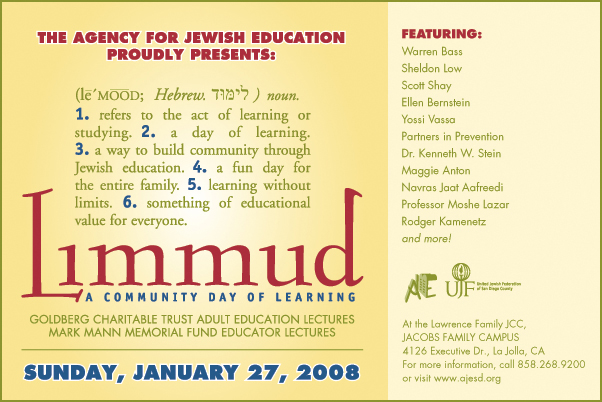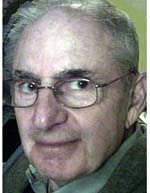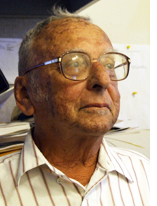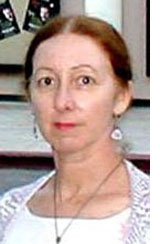Did
Bush have a vision or just a dream?
By J. Zel Lurie
DELRAY BEACH, Florida—President George W. Bush in the last year of his eight-year presidency came to Jerusalem and Ramallah to proclaim his vision of peace and security for Israel.
He has had this vision before but never so emphatically and detailed.
He said all the right things. For the first time, I believe, he proclaimed “End the Occupation,” Women in Black has just celebrated the 2oth anniversary of their weekly demonstration in Paris Square, Jerusalem, holding up signs “End the Occupation” and suffering sexist remarks by passing drivers and acclamations of support by others.
In these twenty years there has been a radical reversal of public opinion among Israeli Jews. From support of the occupiers, that is the Jewish settlers in the West Bank, public opinion has turned around. The majority now agree with Bush’s belated opinion that Israeli and Palestinian security are tied together,
Seven years ago, President Bush was inaugurated. His Democratic predecessor had intervened intensively in the Israel-Palestine dispute presenting draft after draft at Camp David, all of which were rejected by Yasser Arafat.
George Bush was not going to follow in Bill Clinton’s footsteps. For seven years he neglected the Israel-Palestine conflict. Four years ago, the Quartet, consisting of the United States, Russia, the European Union and the United Nations, introduced a Road Map of the steps necessary to the creation of a Palestine State.
Nothing was done to implement it. The Road Map remained buried in the archives, while Hamas captured Gaza and the violence continued.
Now in his eighth and last year, Bush has decided that his legacy should not be devoted solely to the Iraqi disaster. He revived the Road Map calling for ending the rockets from Gaza and the elimination of illegal Jewish outposts. And he tackled Phase Three, the final status negotiations.
Like many Americans George Bush takes the position that since both sides desperately want peace it should be possible for them to compromise on the contentious issues that divide them and meet half way. Here is how he laid out the final peace after two days of meeting with Ehud Olmert and Mohammed Abbas.
On U.N. resolution 194 which gives the Palestine refugees the right of return to Israel or compensation, which has baffled interested parties for sixty years, the solution is simple. “The question could be solved by the creation of a Palestine State and compensation” for those who refuse to move to Palestine.
He went on: ‘There should be an end to the occupation that began in 1967. The agreement should establish a Palestine state as a homeland for the Palestine people just as Israel is a homeland for the Jewish people. The negotiations must ensure that Israel has secure, recognized and defensible borders just as the State of Palestine must be viable, continuous, sovereign and independent.”
Here in two sentences George Bush has solved the contentious issues which have separated the Palestinians and Israelis for many decades. Of course he doesn’t go into details on how to actually solve them as Bill Clinton did. He says get together and compromise to a solution.
On Jerusalem and the sovereignty of the Temple Mount, which .Clinton tried to solve and failed, Bush makes no suggestions,.He says I understand that there are deeply felt religious and national questions. Solve them, please
Palestinians want the separation barrier, the Wall, to come down. Israel wants it to stay up taking away 8 or 9 percent of the West Bank and joining the majority of the settlers to Israel. What will Israel do with the 70 to 80,000 settlers living to the East of the Wall? Bush says they must go or the Palestine State will look like Swiss cheese.
The Palestine State must be contiguous and viable. This means that Gaza must be joined to the West Bank, First, of course, the Hamas terrorists must be eliminated. The rockets must stop flying and the workshops making them must be destroyed.
The Palestine State must be sovereign and independent. This means that the elaborate early-warning defense line on the Jordan frontier must be abandoned, The Israel air force will no longer be able to fly over the West Bank and Gaza at will.
All of which makes me ask. Did George Bush have a vision or just a dream?
There are facts on the ground. Both sides have appointed technical committees to look into the many problems of Palestine statehood including water, electricity and garbage collection.
Tony Blair is working on the Palestine economy. General William Frazer has been appointed to mentor the implementation of the Road Map. President Bush promises to come again and Condi Rice visits so often she might look for a second home in Jerusalem.
It is after all he land where miracles were born. It could happen again. As noted above, public opinion supports it. But by the end of 2008...?
To the Israel press Bush’s visit was another photo-op following Annapolis to bolster Ehud Olmert who in grave trouble. He faces the publication of the Winograd Commission report on January 30. The report is expected to blame him and the Defense Minister and the Chief of staff for the useless deaths of many Israeli soldiers and Lebanese civilians in the summer of 2006. The Defense Minister and the Chief of staff have already resigned. The pressure on Olmert to follow them into oblivion will be intense.
On Thursday evening, Olmert hosted a dinner for Bush, On Friday morning Ha’aretz headlined its report of Bush’s speech, Bush Implores Israel’s Ministers to Keep Olmert.


Jewish angles in the presidential primaries
By Dov Burt Levy
 SALEM, Massachusetts—What can I add to the incessant pontificating on radio, TV and newspapers about the results of the presidential primary? Every commentator will give you enough, maybe too much, to chew on. SALEM, Massachusetts—What can I add to the incessant pontificating on radio, TV and newspapers about the results of the presidential primary? Every commentator will give you enough, maybe too much, to chew on.
But I am paid big bucks [joke] to write about the Jewish angle in public affairs. So here goes.
First, what a difference four years make. In the 2004 Democratic primary, we had Jewish connections everywhere. General Wesley Clark's birth father was Jewish, so were John Kerry's paternal grandparents, as well as Howard Dean's wife and children. And, don't forget Joe Lieberman.
Dov Burt Levy
This year, there are no Jewish connections. I admit that political races with Jewish connections are more interesting for me. For African-Americans, women and voters under 30, this year's political scene has become very exciting. Identification is a mighty thing.
Second, if young people continue the Iowa phenomenon and go to the polls in high numbers, they will have the power to elect the next president.
Ironically, older people have always bemoaned young people's low voting turnout, urging greater involvement by the young in the political fray.
After the next election, many people, maybe even Bill Clinton, may get what they wished for and be sorry for what they got. The famous "law of unintended consequences."
This political participation of the 18-29 year old crowd gives a boost to those members of the Jewish community who for many years, have urgently sought ways to get young people in the Jewish community and to strive for leadership roles.
Along with participation, the hope is that young Jews will have a strong commitment to Jewish continuity, charitable deeds and the well-being of Israel.
Third, of all the hundreds of thousands (millions?) of words during the past weeks in both Iowa and New Hampshire, my Jewish antennae picked up on only two Jewish slurs, both from CNBC's Chris Matthews, commentator on the "Hard Ball" program.
On election night in Iowa, after the results were in, Matthews wondered aloud how "Manhattan and West Hollywood" political contributors would react to Hillary Clinton's poor third place showing. Would she continue to be able to raise big money?
"Manhattan and West Hollywood," when associated with raising political money, are code words for Jews. Why doesn't he just say what he means, "Where will the Jews put their political money now?" That would be dumb to say because even he knows that Jewish-Americans run the gamut of all ideological stripes and are contributors to most of the political candidates.
The second Matthews' foolishness was a question to Mike Huckabee about what Huckabee thought of a breaking story in the Jerusalem Post describing the Republican victor as a Baptist minister turned politician. Just as Huckabee began to answer, Matthews said, "I wouldn't fight with them [Jerusalem Post] if I were you."
What was Matthews really saying? "Don't screw with the Jerusalem Post, or the American Jews will get you." How stupid is that? Big.
Huckabee ignored Matthews and answered, to Matthews' surprise, that the Post story originated with the Associated Press in the United States.
These statements don't approach the level of Don Imus's flagrantly racist remarks last year about an African-American women's basketball team.
I just want Matthews to know that at least one Jew is listening, and unhappily at that.
Were I his boss at CNBC, I'd warn him, "Snide and stereotyped remarks about Jews or anybody else, whether said directly or put into code words, are not acceptable. Period."
The election cycle continues. And while I may continue to suffer boredom and repetition, I am also applauding the passion and speech-making abilities of many of the candidates. From my view, politics and presidential elections are still the best game in town.
Besides, almost every American is looking forward to January 20, 2009, when a new president will be inaugurated.



Dreams in Torah—where are they today?
By Norman Manson
 SAN DIEGO—The spiritual promise of dreams has been forgotten in Judaism - and "having lost this, we want to regain it." That is the major objective of Rodger Kamenetz, scholar, writer and expert on dreams and their meaning, who will be among the featured speakers at the forthcoming Limmud Day of Learning. SAN DIEGO—The spiritual promise of dreams has been forgotten in Judaism - and "having lost this, we want to regain it." That is the major objective of Rodger Kamenetz, scholar, writer and expert on dreams and their meaning, who will be among the featured speakers at the forthcoming Limmud Day of Learning.
Kamenetz will explore the meaning of dreams, and what impact they have - or should have - on Judaism. His topic will be "A History of Last Night's Dream: Discovering the Hidden Life of the Soul," which also is the title of his most recent book.
Norman Manson
The Limmud Day of Learning will be on Sunday, Jan. 27, at the Lawrence Family Jewish Community Center, Jewish Family Campus, at 4126 Executive Drive, La Jolla, under sponsorship of the Agency for Jewish Learning of San Diego County. Kamenetz will open the daylong program when he speaks from 8:30 to 10 a.m.
He is a professor of English and religious studies at Louisiana State University, and has written nine books, including five volumes of poetry, most recently The Lower Case Jew. His best known prose work is The Jew in the Lotus, written following his visit to India and Tibet in the early 1990s. Recently reissued, it is now in its 33rd printing
A reading of the Book of Genesis, the first book of the Torah, would seem to indicate that dreams were a major component of the Judaic religious experience. The stories of Jacob and Joseph include dream sequences which were a major influence in those men's lives. But perusal of the remaining four books of the Pentateuch show that they are almost totally devoid of dream references. According to Kamenetz, the spiritual promise of dreams has been neglected since Genesis.
"We once knew it and it has been forgotten. Dreams convey important messages, and, having lost this, we want to regain it," he said. So, his first objective in studying dreams has been a desire to know what happened to dreams in Judaism.
And his answer is that anxiety in response to dreams has created a fearful response. 'We tend to become intellectual, rather than going into our feelings. Dreams call on us to feel more deeply."
He pointed out that most of the rabbinic sages stressed the anxiety of dreams, and sought to ameliorate this. Their purpose when confronted with dreams was to relieve anxiety, "making the dream good." They ignored the content of the dreams. And, for a few Orthodox communities, this practice persists: They conduct a ceremony in which the rabbi gets three people to swear that "it was a good dream." This fear factor has kept people from taking dreams more seriously.
There have been exceptions to this attitude. Raba, a Talmudic sage, said God will speak to us in dreams. The followers of Isaac Luria, the Kabbalist leader, reported that he dreamed every night. And the renowned Reb Nachman of Bratslav was a dreamer, as noted in his writings and those of others who wrote about him. Dreams are also valued in Jewish mysticism, and tend to be valued by ordinary, non-authoritative people.
In addition to his scholarly and literary pursuits, Kamenetz is a dream therapist. In sessions with his clients, he tries to bring dreams to life in two ways. First, by experiencing the feelings in dreams and second, by treating dreams as if they were real.
A simple example of his procedure that he described was that of a client who dreamed that he had backed up his car and felt a bump. He got out and saw that he had run over a car the size of a hatbox and, surprisingly, the tiny car was undamaged. Still, he went to the driver and gave him his insurance information. Why, if there was no damage, did he do this? The answer is that he is haunted by guilt and the pattern of his life is that he tended to assume more responsibility than necessary. The dream displayed his feelings more clearly than would have occurred in his waking life. Kamaenetz tries to get the dreamer to feel, rather than simply to understand. He tends to call the technique "uninterpretation."
This objective plays into his emphasis on the spiritual rather than the intellectual, and his attempts to bring dreams and their content back into Judaism are closely tied to his efforts in that direction.
Advance tickets for the Limmud Day of Learning are now available, and may be purchased from the Agency for Jewish Education. For further information, call the AJE at (858) 268-9200.

JEWISH CONNECTIONS IN DANCE
How Fiddler on the Roof keeps his balance
By Sheila Orysiek
 SAN DIEGO—Tevye said, “How do we keep our balance?” and then answered his own question - “I can tell you in one word - tradition!” SAN DIEGO—Tevye said, “How do we keep our balance?” and then answered his own question - “I can tell you in one word - tradition!”
Tradition has surely helped our Jewish culture, society, and people maintain stability, however, the very word tradition assumes a static position. Real balance, living balance, is not static, but quite dynamic. Ordinarily, balance is something we notice when it is at risk such as walking a narrow ledge, or when we get dizzy, or when we (some of us) try to balance on the tip of one pointy toe.
Let’s consider the different kinds of balance:
Reflexive balance: We’ve all experienced this when we trip and
Sheila Orysiek
automatically - reflexively - the body acts to right itself. Sometimes a dancer will use this by purposely throwing himself out of balance, to quickly recover - as part of the choreography.
Balance in place: Balance is never actually “in place” because the body is constantly adjusting - it is never truly still. When a dancer is standing on full pointe in fifth position (feet crossed) even though she seems to be absolutely still, if one looks closely there will be constant adjustment (slight movement) taken up in the ankles.
Balance while moving: Walking and running are examples as the body moves from foot to foot in some direction; forward, backward, or side to side. In addition to moving from one step to another, a dancer may strike a pose such as an arabesque and slowly make a complete rotation on one flat foot - (a promenade). This is accomplished by advancing the supporting foot around by inching the heel forward while the rest of the body is kept quiet and the eyes successively spot (look at) the walls and corners of a room; wall, corner, wall, corner, until the rotation is complete. If any other part of the body gets ahead of the supporting heel, it will not only look awkward, but probably won’t succeed in completing the entire rotation. This sounds a lot easier than it is. Balancing while standing still or moving slowly is more difficult than it is while moving quickly.
Balance while turning: Turns can happen in hundreds of different ways but can be divided into those which are sur la place (in one place) or covering ground - stepping out into the turn, or purposely falling out of a turn in some new direction. People who are not dancers experience this when sharply changing direction.
Just as morality comes from a core belief - as the Torah provides us - so does balance; a strong central core. This core for a dancer is located between the lower rib cage and the hips. Put your thumb on the lowest rib and stretch out your hand so that your little finger rests on the top of your hip - now take the rest of the fingers of that same hand and dig them into the space between that lowest rib and the top of the hip. What do you feel? Nothing! No bones; just squishy stuff! It’s that squishy stuff that has to work for you. Again, like morality - it’s not good to be squishy! The only thing that can lend stability to this area of the body is strong muscular control consciously engaged. Strong abdominals will connect the upper part of the torso to the lower half and stabilize both.
The muscles of the abdomen are divided into four quadrants: top right/left and bottom right/left. Each quadrant has to be engaged equally or the body will tip to one side or the other. A trained dancer can tell if her abdominal muscles are unequally held as in: “my lower right quadrant isn’t as strongly held as my upper left quadrant.” She doesn’t say that aloud, however, unless she is among other dancers (the rest of the world isn’t quite ready for this kind of analysis.)
A most important component to balance is the inclination of the body; it has to be forward. Unfortunately many times in school we were told “straighten your shoulders” instead of “relax your shoulders,” and as a result the shoulders were thrown back, putting weight behind the spine. And “chin up” instead of “chin should be level.” And “straighten up” which generally translated into throwing the spine - and consequently the weight - back onto the heels. This is not only impossible to maintain for any length of time (because it is so unnatural), but also leads to compression of the spine - not a good idea. Dancers learn that the weight of the body is elongated up and forward - not pushed back.
Try this…..stand with both feet on the ground, heels almost touching, toes moderately pointing outward to make the shape of a V, all ten toes in contact with the floor (foot isn’t rolling inward or outward) the rest of the body elongated upward (hoisting shoulders is a no-no). Be forward enough so that were you to glance down (without lowering your chin) you can’t see your feet (stomach notwithstanding). Now roll your weight back onto your heels - notice how heavy that feels. It’s also not a position from which you can readily move. However, if you pull forward again so that the majority of your weight - not all - but a majority - is on the front half of your foot - you will feel a lot less heavy and you will be ready to move: walk, run, or dance. This is also a much less tiring position in which to stand when you have to spend time in a check-out line. It will ease your back, too.
This forward alignment is one of the most important rules of the ballet. Why? Because, it works! When a dancer changes direction it is done by pivoting on the front half of the foot - not the heel. Every time a dancer - or you - has too much weight on the heels, in order to move you will have to rock forward anyway.
Balance while moving is much easier then stationary balance as we experience when we ride a bicycle. It’s also why a tight rope walker generally keeps moving. The body doesn’t like to be still. That Fiddler isn’t still either - he is fiddling, after all.
The eyes play a big role in balance. Where we look is generally where we go. We experience this when we drive a car, look to the side for a moment or two and discover the car has begun to move in the direction we’ve been looking. The dancer uses this to his advantage by looking where he is going but he does it without staring or straining the neck.
If a dancer does a pirouette and raises his chin he is likely to fall backward out of the turn and conversely if he lowers his chin he is likely to crumple forward. The chin must be level and the object he is spotting must be eye level; this keeps him correctly aligned - balanced. We automatically align ourselves with the horizon.
It is, of course, possible to move without sight and those who are blind learn to do this. But for those who have sight when suddenly deprived of it - the lights go out - we find ourselves struggling to keep track of where we are in space. A good test of this is walking down a flight of steps in absolute darkness - even with a hand rail it is exceedingly difficult. I don’t recommend trying it. A friend of mine (a man in his twenties) fell down such a flight of steps in a blackout even while holding on to a hand rail.
Balance is also quite sensitive to our general state of health, hormonal cycle, tiredness, incipient cold or other variables. The body changes day to day, and hour to hour. A dancer who performs in a matinee will usually find the balance quite different for a performance that same evening or the following day or the next week. The dancer explores where the balance is for that particular performance and makes adjustments accordingly.
Balance, even when we think we are standing still, is a moving thing. I think tradition ultimately has to be, too.
SAN DIEGO JEWISH WORLD THE WEEK IN REVIEW
Shoshana Bryen in Washington: Just what did Bush say in Israel?
Rabbi Baruch Lederman in San Diego: How our shortcomings can unite us
Rabbi Leonard Rosenthal in San Diego: Mitzvot easier done than other obligations
Ira Sharkansky in Jerusalem: Is Olmert only play acting for Bush
Judy Lash Balint in Jerusalem: Bush security proved a tourist attractionBruce Kesler in Encinitas, California: Gandhi's grandson blames Jews for 'culture of violence' in the Middle EastIra Sharkansky in Jerusalem: Baroque music lovers brave Bush security
Judy Lash Balint in Jerusalem: Bush shuts down Jerusalem traffic
Shoshana Bryen in Washington, D.C.: Bush must make case for Iraq to Arabs
Donald H. Harrison in San Diego: He'll whup you but not until after sundown
Ira Sharkansky in Jerusalem: Olmerts 'illegal settlement' problem
Shoshana BryenDonald H. Harrison Charly Jaffe in San Diego: We worry if we will be accepted to a good college;
they worry if they'll be alive through high school
< BACK TO TOP
|

